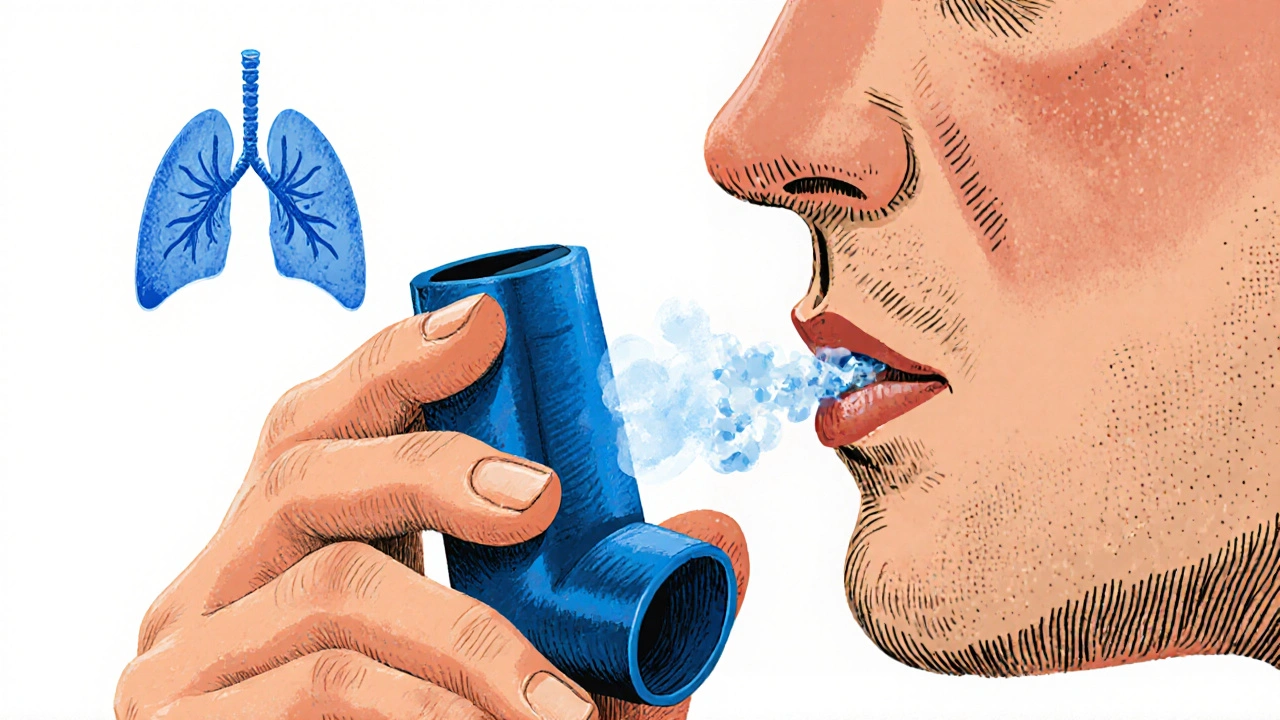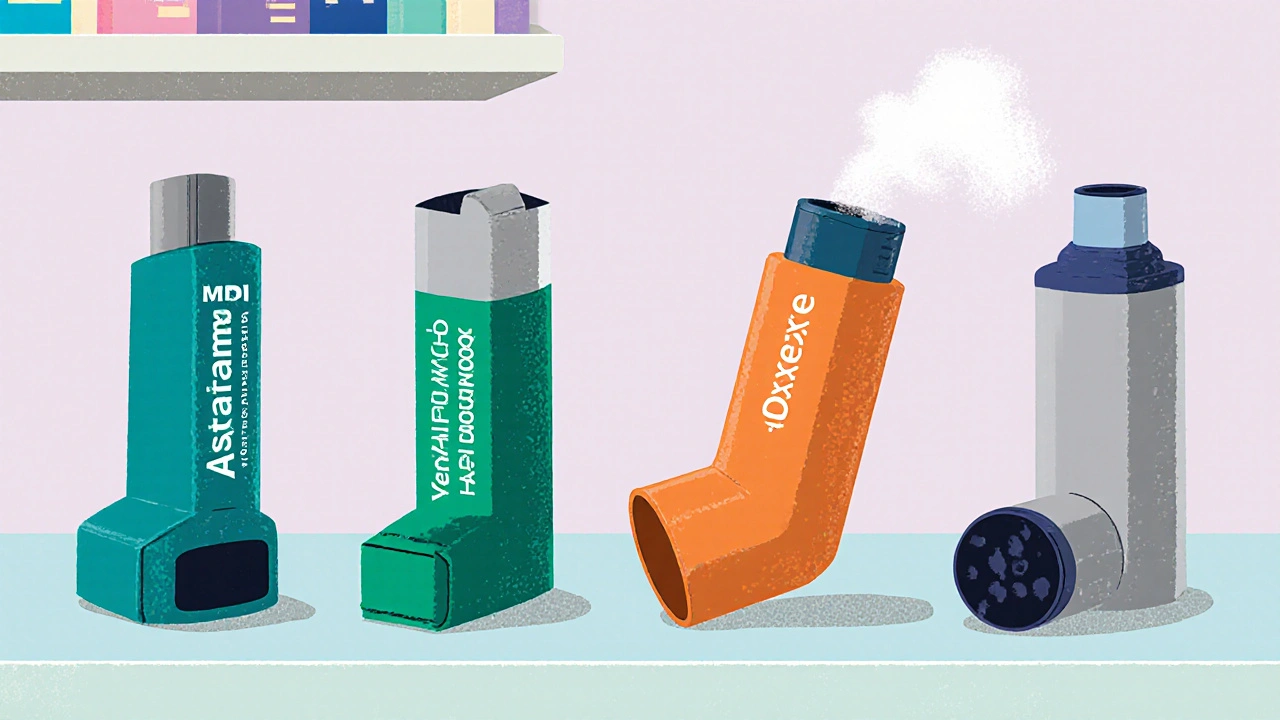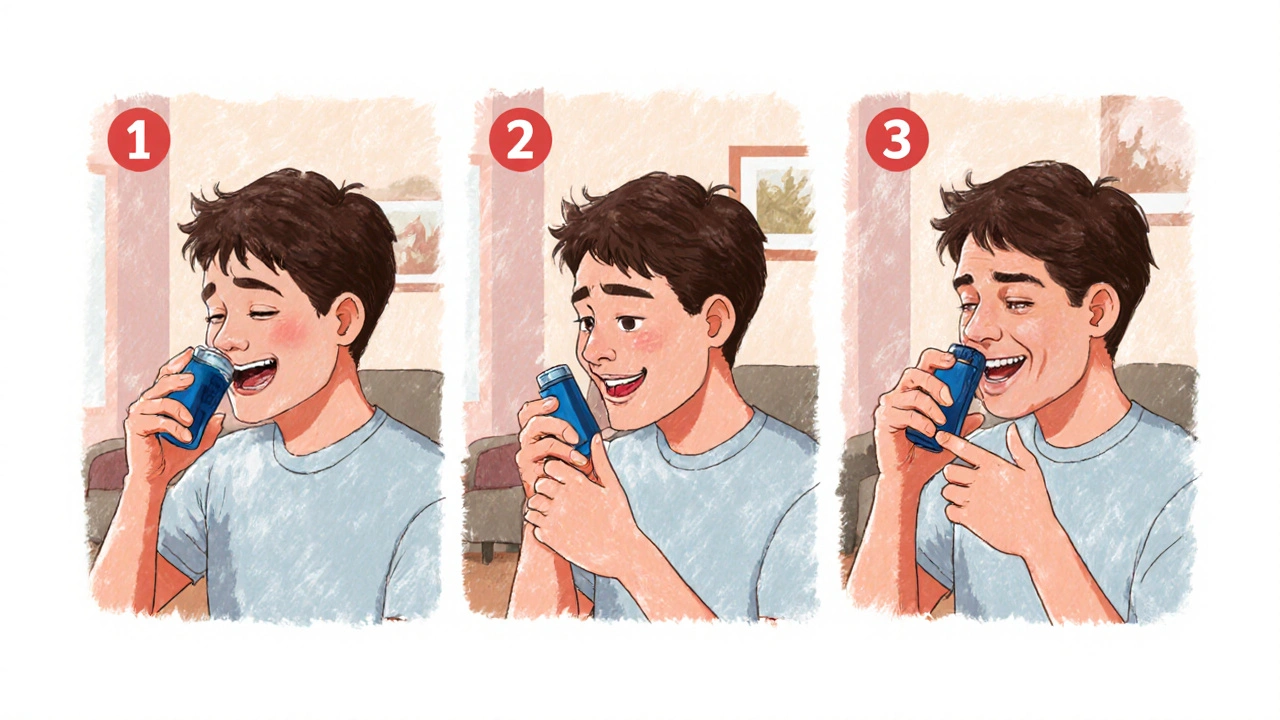Asthalin Inhaler vs Other Salbutamol Options: Pros, Cons & Costs

Inhaler Selection Tool
Find the best salbutamol inhaler for your needs
This tool helps you choose the most appropriate salbutamol inhaler based on your specific asthma treatment requirements.
Answer these questions to get personalized recommendations
Your Recommended Inhaler
When treating asthma, Asthalin Inhaler is a metered‑dose inhaler (MDI) that delivers salbutamol, a short‑acting β2‑agonist bronchodilator, to quickly relieve bronchospasm. It’s been a staple in Canada for years, but the market now offers a handful of alternatives that promise similar relief with different device designs, pricing structures, or side‑effect profiles.
Asthalin inhaler is often the first name that comes to mind when a doctor writes “salbutamol”. Yet patients may wonder whether another brand or a different inhaler type could work better for them. This guide breaks down the most common salbutamol products, compares key attributes, and helps you decide which device fits your lifestyle and budget.
What is Asthalin Inhaler?
The Asthalin Inhaler contains 100 µg of salbutamol per puff, packaged in a traditional press‑urged canister. Each actuation releases a fine mist that reaches the lower airways within seconds. Because it uses a propellant (hydrofluoroalkane, HFA‑134a), the dose is consistent regardless of ambient temperature.
How Salbutamol Works (and Why It’s Popular)
Salbutamol belongs to the short‑acting β2‑agonist class, relaxing smooth muscle in the bronchi and quickly opening constricted airways. The effect kicks in within 5 minutes and lasts about 4‑6 hours, making it ideal for rescue therapy during asthma attacks or exercise‑induced bronchoconstriction.
Top Salbutamol Alternatives on the Canadian Market
While the active ingredient is the same, manufacturers differentiate their products through device technology, dosing options, and pricing. Below are the most widely prescribed alternatives:
- Ventolin HFA - another MDI that uses the same HFA propellant but offers a 200 µg per puff strength.
- ProAir HFA - an MDI praised for its low‑resistance mouthpiece, often recommended for children.
- Oxeze - a dry‑powder inhaler (DPI) that delivers 100 µg of salbutamol per inhalation without a propellant.
- Aerolizer - a less common MDI that bundles a dose counter more prominently.

Side‑Effect Profile Across Products
Because the pharmacology is identical, most side‑effects are shared: tremor, tachycardia, headache, and mild throat irritation. However, inhaler type can influence the frequency of certain complaints. DPIs like Oxeze tend to cause less throat dryness because there is no propellant, while MDIs sometimes trigger a metallic taste due to the HFA carrier.
Detailed Comparison Table
| Brand | Active Dose per Actuation | Device Type | Typical CAD Price (30‑dose) | Onset | Duration | Key Pros | Key Cons |
|---|---|---|---|---|---|---|---|
| Asthalin | 100 µg | MDI (HFA‑134a) | $25‑$30 | ≈5 min | 4‑6 h | Widely available, dose‑counter, reliable spray | Propellant‑related taste |
| Ventolin HFA | 200 µg | MDI (HFA‑134a) | $28‑$33 | ≈4 min | 4‑6 h | Higher dose per puff for severe attacks | May require two puffs for mild symptoms |
| ProAir HFA | 100 µg | MDI (HFA‑134a) | $27‑$32 | ≈5 min | 4‑6 h | Low‑resistance mouthpiece, good for children | Similar propellant taste |
| Oxeze | 100 µg | DPI (powder) | $30‑$35 | ≈5‑7 min | 4‑6 h | No propellant, quieter, less throat irritation | Requires sufficient inspiratory flow; not ideal for very young children |

Factors to Consider When Picking an Inhaler
Beyond price and dosage, think about the following practical aspects:
- Device familiarity: If you’ve used an MDI all your life, switching to a DPI could feel awkward and reduce adherence.
- Inspiratory effort: DPIs need a strong, fast inhale. Patients with severe COPD may struggle.
- Portability & discretion: MDIs are compact and can be used discreetly in public; some DPIs are bulkier.
- Environmental impact: HFA propellants have a higher global warming potential than the propellant‑free DPIs.
- Insurance coverage: Provincial drug plans often list Asthalin and Ventolin as covered; newer brands might require a higher co‑pay.
Tips for Getting the Most Out of Your Rescue Inhaler
Even the best‑priced inhaler won’t help if you use it wrong. Follow these steps each time you need relief:
- Shake the MDI for 5 seconds before each use.
- Exhale fully, but do not exhale into the mouthpiece.
- Place the mouthpiece between your teeth, close lips, and inhale slowly while pressing down once.
- Hold your breath for at least 10 seconds to allow the medication to settle.
- If symptoms persist after 2 puffs, wait a minute and repeat; call your doctor if relief is still inadequate.
For DPIs like Oxeze, make sure the device is dry, load a dose according to the manufacturer’s instructions, and inhale sharply.
Frequently Asked Questions
Is Asthalin interchangeable with Ventolin?
Both contain salbutamol, but Ventolin usually offers a 200 µg dose per puff, which can be useful for severe attacks. For mild to moderate symptoms, 100 µg from Asthalin works just as well.
Can I switch from an MDI to a DPI without a prescription?
In most provinces you need a prescription for any salbutamol product, even if the device changes. Talk to your pharmacist; they can often arrange a switch if the doctor’s note permits.
Which inhaler has the lowest out‑of‑pocket cost?
Asthalin and Ventolin are typically the cheapest, hovering around $25‑$30 for a 200‑dose canister. Generic equivalents may be slightly cheaper but quality varies.
Do DPIs like Oxeze work during an acute asthma attack?
DPIs need a strong inhalation, which can be hard when you’re breathless. Many clinicians still advise an MDI for immediate relief and reserve the DPI for maintenance or in situations where you can inhale forcefully.
Is there a significant difference in side‑effects between brands?
Side‑effects stem from salbutamol itself, not the brand. However, propellant‑based MDIs can cause a metallic or bitter taste, which DPIs avoid.
Ultimately, the right inhaler balances effectiveness, ease of use, and cost. By comparing device type, dosage, and price-just like the table above-you can select the product that keeps you breathing easy without breaking the bank.
Breathing easy is priceless, stay hopeful!
When the wheeze becomes a thunderclap in the chest, remember that the 100 µg puff is a tiny superhero launching into your airways, and its swift rescue is nothing short of a drama worthy of the gods! The physics behind that fine mist is basically a micro‑explosion of relief, and the HFA propellant ensures each particle flies straight to the bronchi. If you ever wondered why a single puff can calm a storm of symptoms, it’s because salbutamol binds to β2 receptors like a key to a lock, instantly relaxing the smooth muscle. Many patients defiantly think a stronger dose means better control, but the 100 µg dosage is calibrated for rapid action without over‑stimulating the heart. So, shake that canister, inhale, and let the miniature miracle do its work – it’s practically a theatrical performance inside your lungs.
Everyone talks about the convenience of HFA propellants, but few consider that the very chemicals pushing the medication out are linked to hidden industrial agendas. The manufacturing of HFA‑134a is tied to big‑oil supply chains, and some whisper that the increased global warming potential is a side‑effect that regulators conveniently overlook. While the medical community praises consistency, there’s a quieter story about how these propellants keep the pharmaceutical giants in a comfortable grip on the market. If you’re looking for a truly independent solution, you might question whether a propellant‑free DPI isn’t the more transparent alternative.
Sure, because a 5‑second shake magically cures everything – sarcasm aside, proper technique still matters.
From a national health policy perspective, endorsing domestically produced inhalers reduces reliance on multinational conglomerates and fortifies our pharmaceutical sovereignty. The Asthalin and Ventolin platforms, being manufactured locally, align with strategic objectives to keep supply chains resilient while maintaining competitive pricing. Moreover, the jargon surrounding “bioequivalence” often masks the geopolitical implications of drug importation. By prioritizing home‑grown options, we also mitigate the risk of price gouging that can occur when foreign entities dominate the market.
Oh, absolutely, because shaking an inhaler is practically a cardio workout – 🙄💪. But hey, at least the propellant‑taste is a delightful reminder that chemistry is everywhere! 😏
When we dissect the market dynamics, it becomes evident that the push for proprietary MDIs is a calculated maneuver to monopolize patient adherence through device familiarity. The argument that a higher‑dose MDI like Ventolin HFA offers superior therapeutic outcomes often ignores the behavioral economics at play – patients are subtly nudged toward brand loyalty because the device feels "right" in their hand. Moreover, the so‑called "dose‑counter" advantage is a veneer that masks the underlying profit model, which thrives on repeat prescriptions and insurance reimbursements. One must also consider the environmental externalities; the HFA propellant, while delivering consistent dosing, contributes disproportionately to greenhouse gas emissions, a factor conveniently omitted from promotional literature. In contrast, DPIs such as Oxeze present a greener footprint, yet their market penetration remains stunted due to a deliberate under‑investment in physician education. The cumulative effect is a healthcare ecosystem that subtly coerces patients into a closed loop of MDI dependence, all while the narrative of "clinical superiority" is repeatedly aired in conferences and marketing leaflets. Hence, the real question isn't merely about pharmacology; it's about who profits from the chosen device and how that influences policy decisions at the governmental level.
That was an insightful deep‑dive; I appreciate how you unpacked the layers beyond just the meds. It’s a reminder that our choices ripple through the system, and staying informed is the best coach we can be for each other.
Exactly-data, cost, & user‑experience converge, so pick wisely!!!
Choosing the right rescue inhaler is more than a price comparison; it’s a matter of technique, pharmacokinetics, and patient lifestyle.
First, understand that all the products listed deliver the same β2‑agonist molecule, so efficacy at the receptor level is essentially identical.
However, the device architecture influences the aerosol particle size distribution, which in turn affects deposition in the lower airways.
MDIs using HFA propellant typically generate particles around 2–3 µm, while dry‑powder inhalers like Oxeze produce a slightly broader range that can be advantageous for patients with good inspiratory flow.
If a patient struggles to generate the required flow-common in severe asthma or during an acute attack-the MDI remains the more reliable option.
From a cost perspective, the table you provided shows that Asthalin and Ventolin sit at the lower end of the market, which often translates to better formulary coverage.
Nevertheless, some provincial drug plans now include generic equivalents that can shave a few dollars off the per‑canister cost, so it’s worth checking the latest formulary updates.
Environmental impact is another factor; HFA‑134a has a global warming potential roughly 1,300 times that of CO₂, whereas DPIs have essentially zero propellant emissions.
Patients who are environmentally conscious may therefore prefer a DPI, provided they can master the inhalation technique.
Speaking of technique, the five‑step MDI checklist-shake, exhale, inhale slowly while actuating, hold breath, and repeat if needed-cannot be overstated.
Skipping the shake or inhaling too fast can reduce the delivered dose by up to 30 %.
For DPIs, the key is a fast, deep inhalation; a slow breath will merely deposit powder in the oropharynx.
Training sessions with a respiratory therapist can dramatically improve adherence and outcomes for both device types.
If insurance coverage forces a switch, clinicians should document the reason and monitor the patient closely for any change in control.
In summary, match the device to the patient’s ability, preferences, and budget, and don’t forget to revisit the choice during routine follow‑up.
A well‑chosen inhaler, used correctly, is the most cost‑effective way to keep asthma under control.
Thanks for the thorough guide! 🌟😊